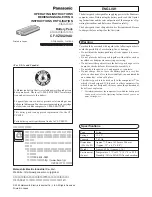
www.lesterelectrical.com 4
35589A
www.fairplayelectriccars.com
Using the charger with any of the above symptoms
could result in a fire, property damage, or personal
injury.
Have your distributor, dealer or other qualified
service agent repair or replace worn or damaged
parts immediately. Repairs should not be attempted
by people who are not qualified.
2. Connect the DC output plug to the battery
receptacle by grasping the plug body or handle
and pushing the plug straight into the receptacle.
The charger will start automatically in three to
five (3-5) seconds.
WARNING: DO NOT DISCONNECT THE DC
OUTPUT CORD FROM THE BATTERY
RECEPTACLE WHEN THE CHARGER IS ON.
THE RESULTING ARCING AND BURNING OF
THE PLUG AND RECEPTACLE COULD CAUSE
THE BATTERIES TO EXPLODE. IF THE
CHARGER MUST BE STOPPED, FIRST
DISCONNECT THE AC POWER SUPPLY CORD
FROM ITS OUTLET, THEN DISCONNECT THE
CHARGER DC OUTPUT PLUG FROM THE
BATTERY RECEPTACLE.
3. Monitor the ammeter for the correct charge rate.
The initial charge rate could vary several amps
from the start current listed in the specifications,
depending upon the condition of the batteries
and how much the batteries have been
discharged.
FLOODED ELECTROLYTE BATTERIES
During charge, the battery voltage increases
gradually which causes the charge rate to
decrease. Good battery cells should each rise
to approximately 2.5 volts per cell DC which will
allow the charge rate to taper to less than 10
amps. Since each cell accepts charge at a
slightly different rate, normal charging with the
ammeter reading in the 5 to 10 amps area for
the last few hours of charge is important to
achieve equalization of all battery cells every
time the batteries are charged.
As batteries age, individual cells weaken
resulting in lower than normal finish charge
voltage. As the finish charge voltage decreases,
the charge rate will no longer decrease and
taper into the 5 to 10 amps range on the
ammeter. The charger will, however, still
determine when the batteries have reached full
charge and turn off. Even though they are
properly charged, older batteries will gradually
lose capacity, and should be replaced when they
will no longer perform as required.
VALVE REGULATED BATTERIES
During charge, the battery voltage increases
gradually which causes the charge to decrease
to near zero and remain there until the charger
turns off. Gel cell deep-cycle batteries will still
taper to near zero charge current even as they
wear out and lose capacity and range. As
sealed deep-cycle batteries lose capacity and
range, the charge current may no longer
decrease to this low a reading. The charger will
still determine when the batteries are as charged
as they are capable of being and turn off. When
the batteries will no longer perform as desired,
they should be replaced.
4. The charger turns off automatically when the
batteries reach full charge. The necessary
charge time is affected by numerous factors.
The major factors affecting the required charge
time are battery amp-hour capacity, depth of
discharge, battery temperature and if the battery
is new or broken in.
5. After the charger has turned off, disconnect the
charger DC output plug from the battery
receptacle by grasping the plug body or handle
and pulling the plug straight out of the
receptacle.
WARNING: TO AVOID DAMAGE TO THE
CHARGER CORD, PLUG, AND BATTERY
RECEPTACLE, DO NOT PULL ON THE
CHARGER CORD. DO NOT TWIST, ROCK, OR
PULL THE PLUG SIDEWAYS.
OFF-SEASON BATTERY STORAGE
MAINTENANCE
When the equipment is not in use, the charger is
designed to be left connected to the batteries with
the AC power on. The charger will periodically
provide a special refresh and conditioning charge to
the batteries during long-term storage to help
overcome battery self-discharge losses and to
reduce sulfation.
Several charge cycles may be required to return the
batteries to their full output after equipment has
been in long term storage.
PROPER CARE OF DEEP CYCLE
MOTIVE POWER BATTERIES
Motive power batteries are subjected to severe
deep-cycle duty on a daily basis. Although these
batteries are designed to withstand such duty, the
following precautions must be observed to obtain
good performance and maximum cycle life:


























